Make Your Healthy Habits Stick

With February coming to an end, I am confident to say that the majority of people have failed with their new year’s resolutions. And to be honest, I empathize with everyone who has ever tried to change their habits and didn’t succeed. I’ve been there too. Multiple times.
I didn't lack motivation, willpower, or self-discipline. I didn't make it because I lacked a strategy and a good understanding of my habits.
So this newsletter is about changing habits, understanding why it's so hard, and what you can do to successfully change your habits... even longer than a few days in January.
Changing our habits can be hard for two reasons:
- we try to change the wrong thing and
- we try to change our habits in the wrong way.
Think back to an annoying habit you've been trying hard to eliminate. Whether it's cutting your sugar consumption or reducing your time on social media, habits can form instantly and are hard to shake.
Time, Strategy, and Understanding
Needless to say that it definitely takes longer than 21 days - changing habits requires more than willpower and self-discipline.
It needs a strategy and a good understanding of how they get established in the first place. And not just the vague idea that I’d like to eat fewer sweets.
A Shortcut for Our Brain
Habits are behaviors that have been repeated enough times to become automatic. They are a shortcut for our brains to save energy and focus on the essentials. The ultimate purpose of habits is to solve the problems of life with as little energy and effort as possible.
So while we're busy brushing our teeth or scrolling through our Instagram feed before falling asleep, we don't have to think much. That's because we've already behaved this way so often that it's ingrained in our brains.
Although habits help us save a lot of time and energy, they can also negatively affect our productivity, health, well-being or happiness. That’s probably not news to you.
But the good news is habits can be broken. Let’s find out how.
How to Successfully Change Behaviors?
The process of changing behavior always begins with awareness. We have to be aware of our habits before we can change them. Realizing that I ate too many sweets was the first step in changing my behavior, but unfortunately, it was not enough.
Four Components
By breaking habits down into four basic components, we can better understand our habits, how they work, and how we can improve them.

All habits proceed through four stages in the same order:
- CueThe two most common cues are time and location. eg. It’s a workday afternoon, and you’re feeling tired.
- Craving
Cravings are the motivational force behind every habit. Without some level of motivation or desire—without craving a change—we have no reason to act. What you crave is not the habit itself but the change in state it delivers.
It’s not the cookie you desire, but you crave the taste of something sweet, and you’ve experienced that you feel energized afterward. - Response, and
The response is the actual habit you perform, which can take the form of a thought or an action. You get something sweet. - Reward.
The response delivers a reward. Rewards are the end goal of every habit.
The cue is about noticing the reward.
The craving is about wanting the reward.
Having something sweet becomes associated with feeling energized in the afternoon to successfully end your working day.
Ask Yourself
in his book Atomic Habits, James Clear describes whenever you want to change your behavior, ask yourself:
- How can I make it obvious? - The Cue
- How can I make it attractive? - The Craving
- How can I make it easy? - The Response
- How can I make it satisfying? - The Reward
Let's say you're trying to get rid of sweets in the afternoon because you know that it’s not healthy and won’t provide long-lasting energy. Ask yourself this, "What triggers my craving for sweets?" and "What need am I trying to satisfy with it?"
Observe Yourself
The next time you hit an energy low, observe:
If you went into the kitchen because you have a little break in the afternoon (cue), and grabbed something sweet (response) because you needed a little pick me up (reward), write it down. After you've done this a few times, you can check to see if it all follows a certain pattern of behavior.
If you always go to the kitchen in a little break between meetings, then you're on the right track.
Recognizing your habits not only helps you find effective alternatives but also makes you more aware of them. This new awareness transforms your habit from an automatic, unconscious routine into an intentional, conscious pattern of behavior.
The Key
The key to creating good habits and breaking bad ones is understanding these fundamental laws and how to alter them to your specifications. And even though you may not nail your new habit every day within the first week, don’t be too hard on yourself. The best thing you can do is to be kind to yourself.
This goes out to all my female readers because when it comes to habits, women report lower confidence than men in maintaining healthy habits and lifestyle activities. Even though numbers show that women have more healthy habits than men.

PS: Two weeks ago, I shared my thoughts on Periods and work. As an update, I am happy to report that Spain is really going with the flow.
Last week, the Spanish parliament said ‘sí’ to paid leave for menstrual cramps. The new law gives women up to five days of medical leave if they’re experiencing a painful period, or as the law describes it, “in case of incapacitating menstruation.” Health experts say about a third of Spanish women fall under that category. Now, Spain's the first European country to approve paid menstrual leave.